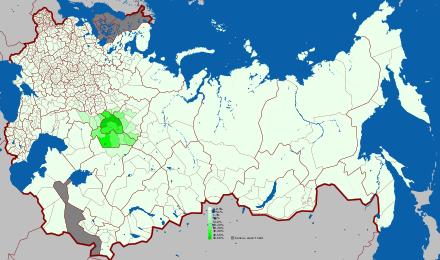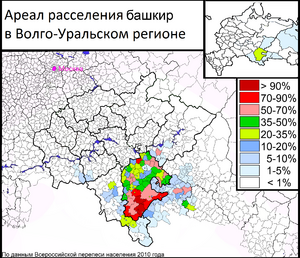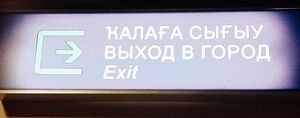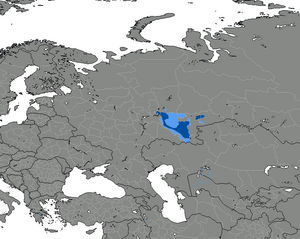اللغة البشكيرية
| Bashkir | |
|---|---|
| Башҡортса, Башҡорт теле | |
| النطق | [bɑʃˈqort tɘˈlɘ]( |
| موطنها | Bashkortostan (Russian Federation) |
| المنطقة | Volga, Ural region |
| العرق | Bashkirs |
الناطقون الأصليون | 1٫4 million (2010 census)e18 |
Turkic
| |
الصيغة المبكرة | |
| Cyrillic (Bashkir alphabet) | |
| الوضع الرسمي | |
لغة رسمية في | Bashkortostan (Russia) |
| ينظمها | Institute of history, language and literature of the Ufa Federal research center the RAS |
| أكواد اللغات | |
| ISO 639-2 | bak |
| ISO 639-2 | bak |
| ISO 639-3 | bak |
| Glottolog | bash1264 |
| Linguasphere | 44-AAB-bg |
 Geographic distribution of Bashkir language in the Russian Empire according to 1897 census | |
Bashkir (/ˈbɑːʃkɪər, ˈbæʃ-/; Bashkir: Башҡортса Bashqortsa, Башҡорт теле Bashqort tele,[1] [bɑʃˈqort tɘˈlɘ](![]() استمع)) is a Turkic language belonging to the Kipchak branch. It is co-official with Russian in Bashkortostan. It is spoken by approximately 1.4 million native speakers in Russia, as well as in Ukraine, Belarus, Kazakhstan, Uzbekistan, Estonia and other neighboring post-Soviet states, and among the Bashkir diaspora. It has three dialect groups: Southern, Eastern and Northwestern.
استمع)) is a Turkic language belonging to the Kipchak branch. It is co-official with Russian in Bashkortostan. It is spoken by approximately 1.4 million native speakers in Russia, as well as in Ukraine, Belarus, Kazakhstan, Uzbekistan, Estonia and other neighboring post-Soviet states, and among the Bashkir diaspora. It has three dialect groups: Southern, Eastern and Northwestern.
المتكلمون

Speakers of Bashkir mostly live in the republic of Bashkortostan (a republic within the Russian Federation). Many speakers also live in Tatarstan, Chelyabinsk, Orenburg, Tyumen, Sverdlovsk and Kurgan Oblasts and other regions of Russia. Minor Bashkir groups also live in Kazakhstan and other countries.
التبويب
Bashkir together with Tatar belongs to the Bulgaric (روسية: кыпчакско-булгарская) subgroups of the Kipchak languages. They share the same vocalism and the vowel shifts (see below) that make both languages stand apart from most other Kipchak and Oghuz Turkic languages.
However, Bashkir differs from Tatar in several important ways:
- Bashkir has dental fricatives /θ/ and /ð/ in the place of Tatar (and other Turkic) /s/ and /z/. Bashkir /θ/ and /ð/, however, cannot begin a word (there are exceptions: ҙур dhur 'big', and the particle/conjunction ҙа/ҙә dha/dhä). The only other Turkic language with a similar feature is Turkmen. However, in Bashkir /θ/ and /ð/ are two independent phonemes, distinct from /s/ and /z/, whereas in Turkmen [θ] and [ð] are the two main realizations of the common Turkic /s/ and /z/. In other words, there are no /s/ and /z/ phonemes in Turkmen, unlike Bashkir which has both /s/ and /z/ and /θ/ and /ð/.
- The word-initial and morpheme-initial /s/ is turned into /h/. An example of both features can be Tatar сүз süz [syz] and Bashkir һүҙ hüź [hyð], both meaning "word".
- Common Turkic /tʃ/ (Tatar /ɕ/) is turned into Bashkir /s/, e.g., Turkish ağaç [aˈatʃ], Tatar агач aghach [ɑˈʁɑɕ] and Bashkir ағас aghas [ɑˈʁɑs], all meaning "tree".
- The word-initial /ʑ/ in Tatar always corresponds to /j/ in Standard Bashkir, e.g., Tatar җылы zhïlï [ʑɤˈlɤ] and Bashkir йылы yïly [jɤˈlɤ], both meaning "warm". However, the eastern and northern dialects of Bashkir have the /j/ > /ʑ~ʒ/ shift.
The Bashkir orthography is more explicit. /q/ and /ʁ/ are written with their own letters Ҡ ҡ and Ғ ғ, whereas in Tatar they are treated as positional allophones of /k/ and /ɡ/, written К к and Г г.
Labial vowel harmony in Bashkir is written explicitly, e.g. Tatar тормышым tormïshïm and Bashkir тормошом tormoshom, both pronounced [tormoˈʃom], meaning "my life".
Orthography

After the adoption of Islam, which began in the 10th century and lasted for several centuries, the Bashkirs began to use Turki as a written language. Turki was written in a variant of the Arabic script.
In 1923, a writing system based on the Arabic script was specifically created for the Bashkir language. At the same time, the Bashkir literary language was created, moving away from the older written Turkic influences. At first, it used a modified Arabic alphabet. In 1930 it was replaced with the Unified Turkic Latin Alphabet, which was in turn replaced with an adapted Cyrillic alphabet in 1939.
The modern alphabet used by Bashkir is based on the Russian alphabet, with the addition of the following letters: Ә ә /æ/, Ө ө /ø/, Ү ү [y], Ғ ғ /ʁ/, Ҡ ҡ /q/, Ң ң /ŋ/, Ҙ ҙ /ð/, Ҫ ҫ /θ/, Һ һ /h/.
| А а | Б б | В в | Г г | Ғ ғ | Д д | Ҙ ҙ | Е е | Ё ё |
| Ж ж | З з | И и | Й й | К к | Ҡ ҡ | Л л | М м | Н н |
| Ң ң | О о | Ө ө | П п | Р р | С с | Ҫ ҫ | Т т | У у |
| Ү ү | Ф ф | Х х | Һ һ | Ц ц | Ч ч | Ш ш | Щ щ | Ъ ъ |
| Ы ы | Ь ь | Э э | Ә ә | Ю ю | Я я |
| Cyrillic version | Pronunciation | Notes |
|---|---|---|
| Аа | [ɑ̜], [ä] | "A" is usually pronounced as [ɑ̜] in all syllables except last, in last syllable it is pronounced as [ä]. |
| Бб | [b] | |
| Вв | [v], [w] | [v] in Russian loanwords, [w] in Arabic and Persian loanwords. |
| Ғғ | [ɣ˗] | |
| Дд | [d] | |
| Ҙҙ | [ð] | In eastern dialect and some of northern subdialects it is an allophone of [d]. |
| Ее | [jɪ̞], [ɪ̞], [je̞], [e̞] | The letter is iotated in beginning of a word, after a vowel or after a soft or hard sign. Also, unlike Russian and other Slavic languages, the letter doesn't palatalize the preceding consonant, except in Russian loanwords. At the word-initial position it is pronounced as [ʑi] in northwest dialect and as [ʝi] in north subdialects of the northwest dialect. The vowel itself is pronounced as [ɪ̞] only in Russian loanwords. |
| Ёё | [jo] | Only used in Russian loanwords. |
| Жж | [ʐ̟] | Only occurs in loanwords. In Russian loanwords it is [ʐ], in Arabic and Persian loanwords it is slightly advanced, [ʐ̟], but it is not a [ʒ]. |
| Зз | [z] | |
| Ии | [i] | Unlike Russian and other Slavic languages, the letter doesn't palatalize the preceding consonant, except in Russian loanwords. |
| Йй | [j] | In west subdialects of northwestern dialect and in a few subdialects of the eastern dialect it is pronounced as [ʑ] at word-initial position. In most other dialects, except the literary standard and southeastern subdialects, it is closer to [ʝ]. |
| Кк | [k] | |
| Ҡҡ | [q] | |
| Лл | [ɭ̺], [ɫ] | In front vowel contexts occurs as apical [ɭ̺], in back vowel contexts occurs as [ɫ]. |
| Мм | [m] | |
| Нн | [n] | |
| Ңң | [ŋ] | |
| Оо | [ʊ̞], [o] | |
| Өө | [ø] | |
| Пп | [p] | |
| Рр | [r] | |
| Сс | [s] | |
| Ҫҫ | [θ] | |
| Тт | [t] | |
| Уу | [u], [w] | |
| Үү | [y], [w] | |
| Фф | [f] | |
| Хх | [χ] | |
| Һһ | [h] | |
| Цц | [ts] | |
| Чч | [tɕ] | |
| Шш | [ʂ] | |
| Щщ | [ɕɕ] | |
| Ъъ | [-] | |
| Ыы | [ɯ], [ɨ] | |
| Ьь | [ʲ] | |
| Ээ | [ɪ̞], [e] | |
| Әә | [æ] | |
| Юю | [ju] | Unlike Russian and other Slavic languages, the letter doesn't palatalize the preceding consonant, except in Russian loanwords. |
| Яя | [jɑ], [ja] | Unlike Russian and other Slavic languages, the letter doesn't palatalize the preceding consonant, except in Russian loanwords. |
Phonology
Vowels
Bashkir has nine native vowels, and three or four loaned vowels (mainly in Russian loanwords).[2]
Phonetically, the native vowels are approximately thus (with the Cyrillic letter followed by the usual Latin romanization in angle brackets):
| Front | Back | |||
|---|---|---|---|---|
| Spread | Rounded | Spread | Rounded | |
| Close | и ⟨i⟩ [i] |
ү ⟨ü⟩ [y~ʉ] |
у ⟨u⟩ [u] | |
| Mid | э, е ⟨e⟩ [ĕ~ɘ̆] |
ө ⟨ö⟩ [ø~ɵ] |
ы ⟨y⟩ [ɤ̆~ʌ̆] |
о ⟨o⟩ [o] |
| Open | ә ⟨ä⟩ [æ~a] |
а ⟨a⟩ [ɑ] |
||
The two mid unrounded vowels are always short, in an unstressed position they are frequently elided, as in кеше keshe [kĕˈʃĕ] > [kʃĕ] 'person', or ҡышы qïshï [qɤ̆ˈʃɤ̆] > [qʃɤ̆] '(his) winter'.[2] Low back /ɑ/ is rounded [ɒ] in the first syllable and after [ɒ], but not in the last, as in бала bala [bɒˈlɑ] 'child', балаларға balalargha [bɒlɒlɒrˈʁɑ] 'to children'.[2] In Russian loans there are also [ɨ], [ɛ], [ɔ] and [ä], written the same as the native vowels: ы, е/э, о, а respectively.[2]
The mid vowels may be transcribed as lowered near-high [ɪ̞, ʏ̞, ɯ̞, ʊ̞], and the close front or close central rounded vowel [y~ʉ] may be transcribed as near-close near-front [ʏ].
Historical shifts
Historically, the Old Turkic mid vowels have raised from mid to high, whereas the Old Turkic high vowels have become the Bashkir reduced mid series. (The same shifts have also happened in Tatar.)[3]
| Vowel | Old Turkic | Tatar | Bashkir | Gloss |
|---|---|---|---|---|
| *e | *et | it | it | 'meat' |
| *ö | *söz | süz | hüdh [hyð] | 'word' |
| *o | *sol | sul | hul | 'left' |
| *i | *it | et | et | 'dog' |
| *ï | *qyz | qëz [qɤ̆z] | qëź [qɤ̆θ] | 'girl' |
| *u | *qum | qom | qom | 'sand' |
| *ü | *kül | köl | köl | 'ash' |
Consonants
| Labial | Labio- velar |
Dental | Post- alveolar |
Palatal | Velar | Uvular | Glottal | ||
|---|---|---|---|---|---|---|---|---|---|
| Nasals | м ⟨m⟩ /m/ |
н ⟨n⟩ /n/ |
ң ⟨ng⟩ /ŋ/ |
||||||
| Plosives | Voiceless | п ⟨p⟩ /p/ |
т ⟨t⟩ /t/ |
к ⟨k⟩ /c/ |
к ⟨k⟩ /k/[1] |
ҡ ⟨q⟩ /q/ |
ь/ъ ⟨’⟩ /ʔ/[2] | ||
| Voiced | б ⟨b⟩ /b/ |
д ⟨d⟩ /d/ |
г ⟨g⟩ /ɟ/ |
г ⟨g⟩ /ɡ/[3] |
|||||
| Affricates | Voiceless | ц ⟨ts⟩ /ts/[4] |
ч ⟨ç⟩ /tɕ/[5] |
||||||
| Fricatives | Voiceless | ф ⟨f⟩ /f/[6] |
ҫ ⟨ś⟩ /θ/ |
х ⟨kh⟩ /χ/ |
һ ⟨h⟩ /h/ | ||||
| Voiced | в ⟨v⟩ /v/[7] |
ҙ ⟨ź⟩ /ð/ |
ғ ⟨gh⟩ /ʁ/ |
||||||
| Sibilants | Voiceless | с ⟨s⟩ /s/ |
ш ⟨sh⟩ /ʃ/ |
||||||
| Voiced | з ⟨z⟩ /z/ |
ж ⟨zh⟩ /ʒ/ |
|||||||
| Trill | р ⟨r⟩ /r/ |
||||||||
| Approximants | у/ү/в ⟨w⟩ /w~ɥ/ |
л ⟨l⟩ /l/ |
й ⟨y⟩ /j/ |
||||||
- Notes
- ^* The phonemes /f/, /v/, /ts/, /tɕ/, /k/, /ɡ/, /ʔ/ are found only in loanwords, and, in the case of /ʔ/, in a few native onomatopoeic words.
- /θ, ð/ are dental [θ, ð], and /r/ is apical alveolar [r̺]. The exact place of articulation of the other dental/alveolar consonants is unclear.
Grammar
A member of the Turkic language family, Bashkir is an agglutinative, SOV language.[2][4] A large part of the Bashkir vocabulary has Turkic roots; and there are many loan words in Bashkir from Russian, Arabic and Persian sources.
Declension of nouns
| Case | father | mother | child | dog | cat | |
|---|---|---|---|---|---|---|
| Singular | Nominative | атай atay | әсәй äsäy | бала bala | эт et | бесәй besäy |
| Genitive | атайҙың ataydhïng | әсәйҙең äsäydheng | баланың balanïng | эттең etteng | бесәйҙең besäydheng | |
| Dative | атайға ataygha | әсәйгә äsäygä | балаға balagha | эткә etkä | бесәйгә besäygä | |
| Accusative | атайҙы ataydhï | әсәйҙе äsäydhe | баланы balanï | этте ette | бесәйҙе besäydhe | |
| Locative | атайҙа ataydha | әсәйҙә äsäydhä | балала balala | эттә että | бесәйҙә besäydhä | |
| Ablative | атайҙан ataydhan | әсәйҙән äsäydhän | баланан balanan | эттән ettän | бесәйҙән besäydhän | |
| Plural | Nominative | атайҙар ataydhar | әсәйҙәр äsäydhär | балалар balalar | эттәр ettär | бесәйҙәр besäydhär |
| Genitive | атайҙарҙың ataydhardhıng | әсәйҙәрҙең äsäydhärdheng | балаларҙың balalardhïng | эттәрҙең ettärdheng | бесәйҙәрҙең besäydhärdheng | |
| Dative | атайҙарға ataydhargha | әсәйҙәргә äsäydhärgä | балаларға balalargha | эттәргә ettärgä | бесәйҙәргә besäydhärgä | |
| Accusative | атайҙарҙы ataydhardhï | әсәйҙәрҙе äsäydhärdhe | балаларҙы balalardhï | эттәрҙе ettärdhe | бесәйҙәрҙе besäydhärdhe | |
| Locative | атайҙарҙа ataydhardha | әсәйҙәрҙә äsäydhärdhä | балаларҙа balalardha | эттәрҙә ettärdhä | бесәйҙәрҙә besäydhärdhä | |
| Ablative | атайҙарҙан ataydhardhan | әсәйҙәрҙән äsäydhärdhän | балаларҙан balalardhan | эттәрҙән ettärdhän | бесәйҙәрҙән besäydhärdhän |
Declension of pronouns
| Interrogative pronouns | Personal pronouns | ||||||||
|---|---|---|---|---|---|---|---|---|---|
| Case | who | what | Singular | Plural | |||||
| I | you (thou) | he, she, it | we | you | they | ||||
| Nominative | кем kem |
нимә nimä |
мин min |
һин hin |
ул ul |
беҙ bedh |
һеҙ hedh |
улар ular | |
| Genitive | кемдең kemdeng |
нимәнең nimäneng |
минең mineng |
һинең hineng |
уның unyng |
беҙҙең bedhdheng |
һеҙҙең hedhdheng |
уларҙың ulardhïng | |
| Dative | кемгә kemgä |
нимәгә nimägä |
миңә mingä |
һиңә hingä |
уға ugha |
беҙгә bedhgä |
һеҙгә hedhgä |
уларға ulargha | |
| Accusative | кемде kemde |
нимәне nimäne |
мине mine |
һине hine |
уны unı |
беҙҙе bedhdhe |
һеҙҙе hedhdhe |
уларҙы ulardhï | |
| Locative | кемдә kemdä |
нимәлә nimälä |
миндә mindä |
һиндә hindä |
унда unda |
беҙҙә bedhdhä |
һеҙҙә hedhdhä |
уларҙа ulardha | |
| Ablative | кемдән kemdän |
нимәнән nimänän |
минән minän |
һинән hinän |
унан unan |
беҙҙән bedhdhän |
һеҙҙән hedhdhän |
уларҙан ulardhan | |
| Case | Singular | Plural | ||||||
|---|---|---|---|---|---|---|---|---|
| this | that | these | those | |||||
| Nominative | был byl |
ошо osho |
шул shul |
теге tege |
былар bylar |
ошолар osholar |
шулар shular |
тегеләр tegelär |
| Genitive | бының bynyng |
ошоноң oshonong |
шуның shunyng |
тегенең tegeneng |
быларҙың bylardhıng |
ошоларҙың osholardhïng |
шуларҙың shulardhïng |
тегеләрҙең tegelärdheng |
| Dative | быға bygha |
ошоға oshogha |
шуға shugha |
тегегә tegegä |
быларға bylargha |
ошоларға osholargha |
шуларға shulargha |
тегеләргә tegelärgä |
| Accusative | быны byny |
ошоно oshona |
шуны shuny |
тегене tegene |
быларҙы bylardhy |
ошоларҙы osholardhy |
шуларҙы shulardhy |
тегеләрҙе tegelärdhe |
| Locative | бында bynda |
ошонда oshonda |
шунда shunda |
тегендә tegenda |
быларҙа bylardha |
ошоларҙа osholardha |
шуларҙа shulardha |
тегеләрҙә tegelärdhä |
| Ablative | бынан bynan |
ошонан oshonan |
шунан shunan |
тегенән tegenän |
быларҙан bylardhan |
ошоларҙан osholardhan |
шуларҙан shulardhan |
тегеләрҙән tegelärdhän |
المراجع
- ^ https://transliteration.eki.ee/pdf/Bashkir.pdf[bare URL PDF]
- ^ أ ب ت ث ج ح Berta, Árpád (1998). "Tatar and Bashkir". In Johanson, Lars; Csató, Éva Á. (eds.). The Turkic languages. Routledge. pp. 283–300. ISBN 9780415082006.
- ^ Johanson, Lars (1998). "The History of Turkic". In Johanson, Lars; Csató, Éva Á. (eds.). The Turkic languages. Routledge. p. 92. ISBN 9780415082006.
- ^ "Overview of the Bashkir Language". Learn the Bashkir Language & Culture. Transparent Language. Retrieved 4 Nov 2011.
للاستزادة
- Poppe, Nicholas (1997) [1964]. Bashkir Manual. Routledge. p. 186. ISBN 978-0-7007-0836-9.
- Грамматика современного башкирского литературного языка (in الروسية). Москва: Наука. 1981.
- Дмитриев, Н. К. (1948). Грамматика башкирского языка (in الروسية). Из-во АН СССР.
وصلات خارجية
- All articles with bare URLs for citations
- Articles with bare URLs for citations from March 2022
- Articles with PDF format bare URLs for citations
- Short description is different from Wikidata
- Languages with ISO 639-2 code
- Languages with ISO 639-1 code
- Articles containing بشكير-language text
- Articles containing روسية-language text
- Pages using Lang-xx templates
- Pages with plain IPA
- CS1 الروسية-language sources (ru)
- اللغة البشكيرية
- لغات إلصاقية
- Subject–object–verb languages
- Kipchak languages
- Languages of Kazakhstan
- Languages of Russia
- Turkic languages
- Vowel-harmony languages
- Languages written in Cyrillic script
